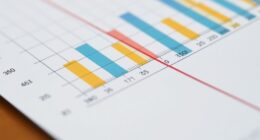Connecting statistics to everyday examples helps you see how data influences your life. For instance, you use probability when checking the weather forecast or making decisions about sports bets. Sampling techniques guide how surveys gather opinions or preferences that shape community plans. Recognizing these connections shows how data reveals insights and supports your daily choices. Keep exploring, and you’ll uncover more ways statistics are part of your routine and decision-making process.
Key Takeaways
- Everyday situations like weather forecasts and sports betting utilize probability models to predict outcomes and manage uncertainty.
- Sampling techniques ensure representative data collection, making insights applicable to larger populations in daily decision-making.
- Combining sampling with probability helps interpret survey results and observations for more accurate real-world conclusions.
- Visual tools and practical approaches, such as projectors in presentations, enhance understanding of statistical concepts in everyday contexts.
- Understanding the role of probability models in daily life allows for informed planning, risk management, and better decision-making.

Have you ever wondered how different ideas and skills come together to create a deeper understanding? When you explore statistics, it’s like uncovering a secret code that explains everyday situations. One way to connect these concepts is by understanding sampling techniques and probability models, which are fundamental tools in statistics. Sampling techniques help you decide how to gather information from a larger group, while probability models allow you to predict and interpret outcomes based on that data. Together, they form a bridge between abstract numbers and real-world experiences.
Imagine you’re trying to determine the popularity of a new coffee shop in your neighborhood. Instead of asking everyone, you might use a sampling technique, like randomly selecting a few residents to survey. This approach saves time and effort while still giving a reliable snapshot of community opinions. By choosing a good sampling method, such as simple random sampling or stratified sampling, you ensure your results are fair and representative. Once you gather your data, probability models come into play. They help you understand the likelihood of certain results, like what percentage of residents prefer the new coffee shop over existing ones. These models can also help you assess the chance that your sample accurately reflects the larger population, which is critical for making informed decisions.
Sampling methods ensure fair, representative data; probability models predict outcomes and assess accuracy for informed decisions.
In everyday life, probability models are everywhere. Think about weather forecasts—they use data and probability to predict if it’s likely to rain tomorrow. If the weather service reports a 70% chance of rain, they’re using probability models based on historical weather patterns and current conditions. Similarly, in sports betting, odds are calculated using probability to determine how likely a team is to win. These examples show how probability models help us make sense of uncertainty and plan accordingly.
Understanding sampling techniques enhances your ability to gather meaningful data, whether you’re conducting a survey or just observing your surroundings. When you combine this with probability models, you gain a powerful toolkit for interpreting that data and making predictions. It’s like turning raw information into actionable insights. For instance, if you’re organizing a community event, you could sample opinions on preferred dates and use probability models to estimate turnout. This practical approach makes it easier to plan and succeed. Additionally, advancements in projector technology have made it easier to visualize survey results or data analyses during presentations, which can further aid understanding and decision-making.
Frequently Asked Questions
How Can I Identify Relevant Statistics in Daily Life?
You can identify relevant statistics in daily life by paying attention to data sources like news reports, social media, or product labels. Use context analysis to assess if the data applies to your situation, asking if it’s recent, credible, and representative. Look for clear numbers that support claims or decisions, and compare different sources to see if the statistics align, helping you make informed choices.
What Are Common Pitfalls When Applying Statistics Outside Academia?
You should watch out for misleading graphs that distort data and sampling errors that skew results. These common pitfalls happen when visuals exaggerate differences or when the sample isn’t representative of the whole population. For example, a graph with truncated axes can make small changes look huge, misleading your interpretation. Always question the source, examine how data was collected, and beware of visual tricks to avoid drawing false conclusions.
How Do Cultural Differences Affect Interpreting Statistical Data?
You should be aware that cultural bias influences how you interpret statistical data, as different cultural backgrounds shape your perceptions and expectations. Interpretation challenges arise when data is viewed through a lens shaped by your cultural norms, leading to misunderstandings or misrepresentations. To avoid this, consider the cultural context behind the data, question your assumptions, and seek diverse perspectives to gain a more accurate and balanced understanding.
Can Statistics Accurately Predict Individual Behaviors?
They say, “Statistics are like a map, not the territory.” You should know that, while statistics can offer insights, they can’t accurately predict individual behaviors because of predictive limitations and individual variability. You can’t rely solely on data to see exactly what one person will do. Instead, use statistics as a guide, understanding that each person’s actions may differ markedly from the averages or trends.
How Can I Use Statistics to Improve Personal Decision-Making?
You can use statistics to improve personal decision-making by focusing on probability estimation and risk assessment. By analyzing relevant data, you’ll better understand the likelihood of various outcomes, helping you weigh options more effectively. Always consider potential risks and benefits, and use statistical insights to make informed choices. This approach reduces guesswork, increases confidence, and helps you navigate life’s uncertainties with a clearer, data-driven perspective.
Conclusion
By seeing how statistics relate to everyday life, you’ll find it easier to understand and apply them. Remember, “a picture is worth a thousand words,” and the same goes for data. When you connect concepts to real-world examples, complex ideas become clearer and more meaningful. Keep practicing, stay curious, and you’ll see how statistics can become a valuable tool in your daily decision-making. Knowledge is power—so never stop exploring and connecting!










